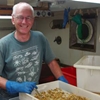General Description
Body chocolate to chestnut brown in color, carapace with irregular whitish patches, abdomen with narrow whitish longitudinal stripes; major chela dark orange to brown with distal portions whitish. Carapace length up to 1 cm.
Biology
Snapping shrimps or pistol shrimps are immediately distinguished from other families by having one claw much larger than the other, the larger claw cylindrical and with a parrot-beak-like finger. The snapping apparatus on the claw involves a piston at the base of the moveable finger that fits into a cavity of the fixed finger. When clicked closed by the strong muscles in the palm, a sudden jet of water is expelled to stun its prey, such as crabs and fishes. A sharp click is heard at the same time and may even be audible to us when walking over mudflats where the shrimps can be common.
Habitat
In heads of dead coral, intertidal pools, depths to 6 m.
Reefs
Soft substrates
Coastal shores
Distribution guide
Indo-west central Pacific Oceans (East Africa to Ryukyu Islands, east to Hawai'i) including south-eastern and south-western Australia.
Species Group
Prawns, shrimps, lobsters › Shrimps
Depth
Water Column
Max Size
1 cm
Diet
Organic matter
Commercial Species
No
Global Dispersal
Recorded in Australia
Conservation Status
- DSE Advisory List : Not listed
- EPBC Act 1999 : Not listed
- IUCN Red List : Not listed






